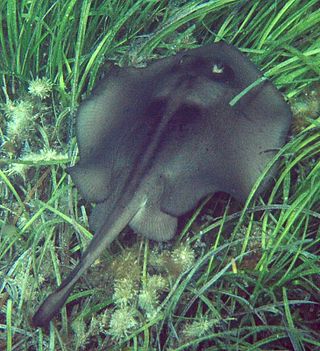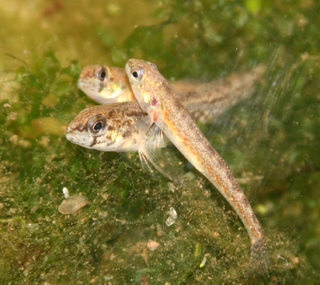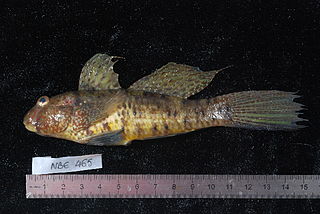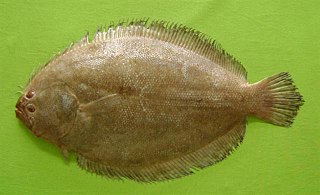
The sand goby, also known as a polewig or pollybait, is a species of ray-finned fish native to marine and brackish waters European waters from the Baltic Sea through the Mediterranean Sea and into the Black Sea where it occurs in sandy or muddy areas of inshore waters at depths of from 4 to 200 metres. This species can reach a length of 11 centimetres (4.3 in) TL. This species is sometimes kept in public aquariums. The sand goby is of a sandy colour, with darker markings on the sides and a creamy-white underside. In the breeding season the male fish has blue spot at the rear of the first dorsal fin, ringed with white. The fish has a slender body, and the head is about a quarter of the total length.

The black goby is a species of ray-finned fish found in the Eastern Atlantic and Mediterranean Sea and Black Sea. It inhabits estuaries, lagoons, and inshore water over seagrass and algae. It feeds on a variety of invertebrates and sometimes small fish. This species can also be found in the aquarium trade.

The sheepshead minnow, also known as sheepshead pupfish, is a species of ray-finned fish in the family Cyprinodontidae, the pupfishes. It is found in salt marsh and estuary environments and is native to the eastern coasts of North and Central America.
The glassy sprat is a type of sprat fish. The fish, when alive, is translucent, so it gets the second word in its scientific name from the Latin word translucidus, meaning transparent, diaphanous. In animal classification the glassy sprat belongs to Osteichthyes, Clupeiformes, Clupeidae, Hyperlophus. The glassy sprat is native to Australia and mainly found in Australia. It is marked as NE because it has not yet been evaluated by the World Animal Protection. It is mainly used as an economical aquatic product. In ecosystems, they are at the bottom end of the food chain, feeding mainly on plankton, which are less aggressive and very vulnerable to other fish. Glassy sprat are tiny in size and translucent with a silvery streak that extends from its tail to just behind its head. As early as a hundred years ago, Australians harvested the glassy sprat in large quantities and it featured on the table as food for a long time. Due to its poor appearance, it is not a very good ornamental fish.

The striped stingaree is a common but little-known species of stingray in the family Urolophidae, endemic to shallow, inshore waters off southwestern Australia. Reaching 61 cm (24 in) long, this species is characterized by an oval, grayish to brownish disc with darker mask-like markings around the eyes and paired blotches at the center of the disc that are extended posteriorly into horizontal lines. Its nostrils have enlarged lobes on the outer margins and a skirt-shaped curtain of skin with a deeply fringed trailing margin in between. Its tail terminates in a relatively large leaf-shaped caudal fin, and bears a small dorsal fin just before the stinging spine. The rounded, flexible disc of the striped stingaree enable it to maneuver through the rocks, reefs, and seagrass that comprise its favored habitats. The International Union for Conservation of Nature (IUCN) has listed this species under Least Concern; it is seldom caught by fisheries due to its habitat preferences.
The masked stingaree is a common species of stingray in the family Urolophidae, endemic to southwestern Australia. It prefers moderately deep areas of sand or seagrass some distance from shore, though it can be found in very shallow water or to a depth of 115 m (377 ft). The masked stingaree can be identified by the two large, dark blotches on the upper surface of its rounded pectoral fin disc, one of which encompasses its eyes like a mask. The outer rims of its nostrils are expanded into prominent lobes, while between the nostrils is a skirt-like curtain of skin with a deeply fringed trailing margin. Its tail bears a small dorsal fin just before the stinging spine, and end in a leaf-like caudal fin. This species grows up to 31 cm (12 in) across.

The two-spotted goby is a species of goby native to marine and brackish waters of the eastern Atlantic Ocean where it can be found from the Faeroes and Norway to the northwestern coast of Spain. It has also been recorded from Estonia though records from the Mediterranean Sea are uncertain. They are common on all coasts of the United Kingdom. This species can reach a length of 6 centimetres (2.4 in) TL.

Glossogobius giuris, the tank goby, is a species of goby native to fresh, marine and brackish waters from the Red Sea and East Africa through South Asia and the Indian Ocean to China, Australia and the islands of the Pacific Ocean. This species can also be found in the aquarium trade. It is also known as the bar-eyed goby, flat-headed goby and the Gangetic tank goby.

The doubleband surgeonfish or lieutenant tang, is a marine ray-finned fish in the family Acanthuridae. It is found in the tropical and sub-tropical Indo-Pacific region and grows to a maximum length of 31 cm (12 in).
Gobioclinus gobio is a strictly marine ray finned fish, also called Gobioclinus gobio. Its common name is the palehead blenny, and is sometimes referred to as the goggle-eye blenny. It can be identified by its greenish top, red belly, and multicolored banding. L. gobio is a benthic organism with a wide range, taking up residence in a number of coastal environments from Florida to Brazil. This means the fish can live in equatorial, subtropical, and tropical climatic zones. It is native to coastal areas of the Caribbean. Its diet consists mainly of different molluscs and echinoderms.

Etheostoma exile, the Iowa darter, is a species of freshwater ray-finned fish, a darter from the subfamily Etheostomatinae, part of the family Percidae, which also contains the perches, ruffes and pikeperches. It is, along with about 17 other species of darters, is native to the lakes and streams of Iowa.

Spinachia is a monospecific genus of ray-finned fish belonging to the family Gasterosteidae, the sticklebacks. The only species in the genus is Spinachia spinachia, the sea stickleback, fifteen-spined stickleback or fifteenspine stickleback, a species which lives in benthopelagic and in brackish environments of the northeastern Atlantic Ocean. This species, the largest of the sticklebacks, grows to a length of 22 centimetres (8.7 in) SL. This species is the only known member of its genus Spinachia. It is of no interest as a commercial fish.

The arrow goby is a species of goby native to marine and brackish waters of the Pacific coast of North America from British Columbia to Baja California. This species grows to a length of 6.4 centimetres (2.5 in) SL, though most do not exceed 4.2 centimetres (1.7 in) TL. This fish can also be found displayed in public aquaria. This species is the only known member of its genus.

Valenciennea helsdingenii is a species of goby from the Indo-Pacific. It is commonly known as the twostripe goby, black-lined sleeper goby, or railway sleeper goby. It can grow up to a length of 25 cm (9.8 in) and is distinguishable by two prominent orange to black lines running longitudinally through its body.

Monacanthus ciliatus, commonly known as the fringed filefish, the cuckold or the leather-fish, is a species of bony fish commonly found in shallow water in the western Atlantic Ocean, the Caribbean Sea and the Gulf of Mexico.

Amblygobius sphynx or the Sphinx goby is a species of goby found in brackish and salt water in the Indo-West Pacific region.
Gnatholepis gymnocara, the Nakedcheek sandgoby, is a small species of ray-finned fish in the subfamily Gobionellinae. The Naked cheek sandgoby is found primarily in the Indian Ocean along the coast of Australia.

Pseudorhombus arsius, the largetooth flounder, is a species of left-eyed flatfish, that is the dark side with the eyes on the adult fish is the left side of the fish's body, from the family Paralichthyidae. As Rhombus polyspilos it was named as the type species of the genus Pseudorhombus. It is an Indo-Pacific species and is fished for by both recreational and commercial fisheries.
Pseudogobiopsis oligactis, the bigmouth stream goby, is a species of goby from the subfamily Gobionellinae of the family Oxudercidae which is widespread in southern Asia.
The Red Sea goby is a species of true goby from the family Gobiidae. It was once a species confined to the Red Sea but it has colonised the Suez Canal and the south-eastern Mediterranean by Lessepsian migration.
















